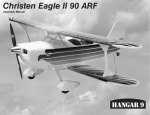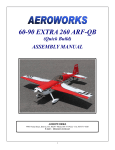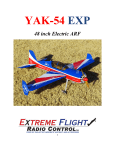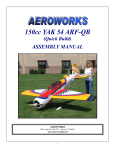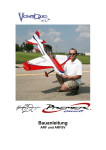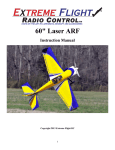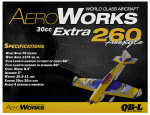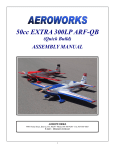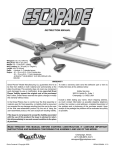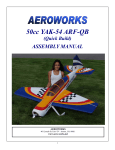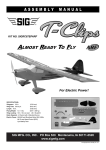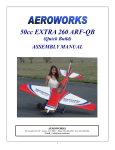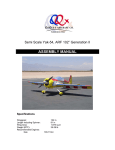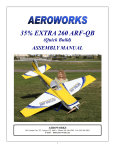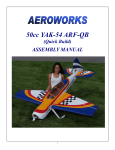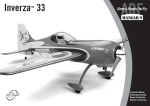Download 90-120 YAK Assembly Manual
Transcript
.90-1.20 YAK 54 ARF-QB (Quick Build) ASSEMBLY MANUAL AEROWORKS 401 Laredo St. Unit “D” - Aurora, CO. 80011 www.aero-works.net 1 TABLE OF CONTENTS Page Aeroworks Contact Information / Shipping Damage………………………………………… 3 Introduction / Warranty…………………………………………………………………………. 4 Kit Contents……………………………………………………………………………………… 5 Items Needed To Complete ……………………………………………………………………... 8 Tightening and Re-shrinking The Covering ………………………………………………….. 9 Checking Seams and Color Overlaps for Good Seal / Sealing Hinge Gaps ………..……….. 10 Wing Assembly………………………………………………………………….……………….. 11 Stab and Elevator Assembly……………………………………………………………………. 16 Rudder, Rudder Servo and Tail wheel Assembly …………………………………………… 20 Main Landing Gear and Wheel Pant Assembly …………………………………...…………. 32 Engine, Muffler and Throttle linkage installation………………….………..………………... 37 Fuel Tank Assembly and Installation ………………………………………………………….. 52 Cowl Installation.…. …………………………………………………………………………….. 56 Radio Installation.…. ………………………………………………………………………...….. 61 Preflight Preparation …………………………………………………………………………….. 65 Decal installation ………………………………………………………………………………… 67 Center of Gravity / Control Throws ……………………………………………………………. 71 Preflight Check List ……………………………………………………………………………... 74 2 401 Laredo street Unit D Aurora, CO. 80011 Phone: (303) 366-4205 - Fax: (303) 366-4203 Website: www.aero-works.net - E-mail: [email protected] Thank you for choosing the Aeroworks .90-1.20 YAK 54 ARF-QB. We put great effort into making this plane the best model you will ever build and fly. We have provided you with the highest quality kit and performance possible. We wish you great success in the assembly and flying of your new Aeroworks .90-1.20 YAK 54 ARF-QB. !WARNING! An R/C aircraft is not a toy! If misused, it can cause serious bodily harm and property damage. Fly only in open areas, and AMA (Academy of Model Aeronautics) approved flying sites. Follow all instructions included with your plane, radio, and engine. Aeroworks manufacturing guarantees this kit to be free from defects in both material and workmanship at the date of purchase. This warranty does not cover any component parts damaged by use or modification. In no case shall Aeroworks liability exceed the original cost of the purchased kit. Further, Aeroworks reserves the right to change or modify this warranty without notice. In that Aeroworks has no control over the final assembly or materials used for final assembly, No liability shall be assumed nor accepted for any damage resulting from the use by the user of the final user-assembled product. By the act of using the user-assembled product, the user accepts all resulting liability. !SHIPPING DAMAGE! Aeroworks has taken extreme steps to prevent your model from possible shipping damage. However, shipping damage may still occur. If your model is received with any damage as the result of shipping, it is important that you retain both the inner white and outer brown boxes and notify Aeroworks IMMEDIATELY for further steps to process your claim. Failure too comply may result in the inability to process your damage claim. We, as the kit manufacturer, have provided you with a top quality, thoroughly tested kit and detailed instructions, but ultimately the quality and fly ability of your finished model depends on how you build it; therefore, we cannot in any way guarantee the performance of your completed model, and no representations are expressed or implied as to the performance or safety of your completed model. 3 INTRODUCTION Your new .90-1.20 YAK 54 ARF-QB is a highly aerobatic airplane. It is capable of both precision and 3-D maneuvers. The aircraft builds easily, quickly, and precisely due to the revolutionary QB (Quick Build) Design, LASER cut technology, and high quality included hardware. We hope you enjoy building and flying your .90-1.20 YAK 54 ARF-QB. Great care has been taken in both the design and manufacturing of the .90-1.20 YAK 54 ARF-QB to allow for the strongest and lightest construction possible. Only the highest quality materials from the covering, paint, wood and hardware have been used in the construction of this model. The .90-1.20 YAK 54 ARF-QB has been individually hand built, covered and painted by trained and experienced craftsmen with over 27 years of manufacturing experience. Using CAD design, laser cut technology and jig-built assures accuracy in all stages of production. The .90-1.20 YAK 54 ARF-QB is designed for engines in the .90 to 1.20 category. The Saito 1.25 4stk and OS 1.20AX 2stk. engines are shown in the assembly instructions. The aircraft was tested with both engines and has outstanding performance. The final choice of engine is left up to the builder. A computer radio is recommended to allow the pilot to take advantage of the full capabilities of this aerobatic aircraft. IMPORTANT Please read through this assembly manual carefully, before starting the assembly of your new .90-1.20 YAK 54 ARF-QB. Inventory and inspect all parts and hardware for any imperfections or damage. Please notify Aeroworks immediately if there are missing or damaged parts. INTENDED USE This plane should not be regarded as a toy. This is an aerobatic plane and is recommended for pilots who are beyond the trainer-stage and are comfortable with flying an aerobatic sport plane. READ! WARRANTY READ! It is important to notify Aeroworks of any damage or problems with the model within 30 days of receiving your airplane to be covered under warranty. If you wish to return this aircraft for any reason a 15% restock fee will be charged to the customer. In addition the customer is responsible for all return shipping cost and all prior shipping cost will not be refunded. Parts will be exchanged or replaced once the original item is returned at the owner’s expense. If you have any problems or questions, please contact Aeroworks. Aeroworks cannot insure the skill of the modeler and cannot influence the builder during the construction or use of this aircraft, and therefore, will not be accountable for any property damage, bodily injury or death caused by this aircraft. Aeroworks cannot insure the skill of the modeler and cannot influence the builder during the construction or use of this aircraft, and therefore, The purchaser/operator accepts all responsibility of any and all structural or mechanical failures. 4 KIT CONTENTS (1) 3.5(o.d.) x 750mm Antenna guide tube installed (2) 3.5(o.d.) x 70mm rudder pull-pull exit tubes installed .90-1.20 YAK 54 ARF-QB Basic Aircraft Parts: Fuselage - vertical fin installed - pre drilled for the Left Wing with Aileron – covered - hinges installed and glued - Pre-drilled for the mounting of the control horn (1) 8-32 blind nut installed for the wing mounting. (2) Aluminum anti-rotation dowels - installed predrilled hole for cotter pin installation (6) pin point hinges (glued) Read to fly (1) Aileron servo pull string installed hinges– covered - firewall fuel-proofed - muffler tunnel pre painted - pre drilled for mounting of the tail wheel assembly. (4) 8-32 blind nuts installed in firewall for mounting of the engine mounts (4) 8-32 blind nuts installed for main landing gear (4) 4-40 blind nuts installed for the mounting of the stab (4) 4-40 blind nuts installed for the mounting of the cowling (1) Gear cover for the landing gear –covered, installed by (2) T2.6x12mm PWA screws (1) Canopy base-painted, installed on the fuselage by (4) 4-40 blind nuts and (4) 4-40x10mm hex style bolts (1) Tinted Canopy—glued on the canopy base and painted (4) #6 bonded washers for the mounting of the canopy base (4) 3mm split lock washers for the mounting of the canopy base Right Wing with Aileron – covered - hinges installed and glued - Pre-drilled for the mounting of the control horn (1) 8-32 blind nut installed for the wing mounting. (2) Aluminum anti-rotation dowels - installed predrilled hole for cotter pin installation (6) pin point hinges installed (glued) Read to fly (1) Aileron servo pull string installed Horizontal Stabilizer with elevator assembly—covered (8) 4 per elevator, pin point hinges (glued) Ready to fly Elevators Pre-drilled for the mounting of the control horns 5 #6: Rudder with (5) pin point hinges (not glued) – covered Rudder Pre-drilled for the mounting of the hinges, control horns and tail wheel steering arm. (2) 4-40 x 3” Two end threaded pushrod with nuts and clevises for ailerons (2) 4-40 x 5 1/2” Two end threaded pushrod with nuts and clevises for elevators (1) 2mm x 300mm One end threaded pushrod with lock nut - throttle (1) 3.5mm x 400mm plastic guide tube - throttle (1) nylon clevis - throttle (1) plastic quick link - throttle (2) plywood support brace - throttle (1) servo mounting tray - throttle (4) 4-40 Ball Links – 2 for ailerons; 2 for elevators (4) Brass spacers – for ball links SUB ASSEMBLIES: #1: (1) Fiberglass Cowling- painted - pre mounted (4) 4-40 x 10mm hex style bolts for mounting cowl (4) #6 bonded washers for mounting cowling (4) 3mm split lock washers for mounting cowling #2: (1) 3mm 7075Aluminum Main Landing Gear -- painted (2) 4mm x 33mm Axle Bolts (2) M4 lock nuts (2) 4mm flat washers (4) 4mm i.d. Wheel Collars with set-screws (2) 63mm Dia. Main Wheels (Lite-Type) (4) 4-40 x 10mm hex style bolts for mounting wheel pants (4) 3mm flat washer for mounting wheel pants (4) 3mm split ring lock washer for mounting wheel pants (4) 8-32 x 16mm hex head bolts for mounting main landing gear (4) 4mm flat washers for mounting main landing gear (4) 4mm split ring lock washers for mounting main landing gear. #7: (2) 0.8 x 850mm plastic coated pull-pull steel cable. (4) M2 Metal R/C links with metal clevises and nuts (4) 3 x 4mm brass pull-pull swaging tubes (3) AW control horn - Left (3) AW control horn - Right (24) T2.6 x 12mm Phillips head mounting screws #8: (1) 450cc (15.2 ounce) - Fuel Tank assembly (1) 2ft. fuel line - glow #9: (1) Plywood - Fuel tank retainer (1) 130 x 70 x 6mm foam - Fuel tank (2) 300 x 80 x 6mm foam - Receiver and Battery (2) 5mm Nylon ties - Receiver and Battery (1) 356 x 12.5mm Velcro (one wrap) Strap - fuel tank (1) Pre-made Cowl template - cutting hot air exit holes - 3 pcs. set (2) 200 x 280mm card stock - template material for cutting cowling #3: (2) Wheel Pants- Painted- pre mounted- 1 Left and 1 Right-(4) 4-40 blind nuts installed in the wheel pants, 2 per side. #4: (1) Tail Wheel Assembly - (small) (1) Aluminum steering arm and mounting screws (2) Steering springs #10: Ultracote™ - Small patches and repairs (1) (1) (1) (1) (1) #5: (1) 20mm O.D. x 654mm Carbon wing tube (1) 8mm O.D. x 92mm Carbon stab tube - Front (1) 8mm O.D. x 290mm Carbon stab tube - Rear (2) 8-32 x 25mm Hex head bolts for wing mounting (2) #8 bonded washer for wing mounting (2) 4mm split ring lock washers for wing mounting (4) 4-40x10mm Hex style head bolts for stab mounting (4) #6 bonded washer for stab mounting (4) 3mm split ring lock washers for stab mounting (4) 1.8mm cotter pins - Second method -wing mounting for security 300x300mm Midnight Blue #HANU885 300x300mm True Red #HANU866 300x300mm Dark Yellow #HANU889 300x300mm White #HANU870 600x300mm Transparent covering -Sealing hinge gaps #11 (1) 3” Spinner assembly - white #12 (2) Adjustable engine mounts - 1 Left - 1 Right (8) 8-32 x 30mm Hex head bolts - mounting of engine mounts and engine (4) 8-32 Lock nuts - engine mounting (4) 4mm flat washer - engine mounting (4) 4mm split washer - engine mounting 6 #13: (1) Custom -Vinyl Decal Set #14 (1) Assembly manual on CD - with picture folders 7 ITEMS NEEDED TO COMPLETE Hardware: • • • • • • • • • • • • • • • • • • • • • • • • • • • • • .90 to 1.20 glow two stroke or four stroke engine with muffler Propeller of your choice 2 x aileron servos (min. 140 in./oz. Digital, Metal Gear) 1 x rudder servo (min. 180 in./oz each, Digital, Metal Gear) 2 x elevator servos (min. 140 in./oz. Digital, Metal Gear) 1 x throttle servo (fast / reliable) Servo arms - 2 x 1” Ailerons, 2 x 1” Elevators, 1 x 2” (duel arm) Rudder Servo extensions Heavy Duty - (22 gauge min) 4 x 6”(Aileron, Receiver), 1 x 12”(Throttle), 2 x 18” (Elevators) 1 Receiver (PCM recommended) 1 Receiver battery (min 6.0 volt / 1700ma) 1 switch with charge jack (22 Gauge min) 2 Fuel “T”, 1 Fuel filter Allen wrenches US and Metric. Dremel cutting disc and sanding drum tool Electric drill and selection of bits Flat head screwdriver Hobby heat gun Hobby iron with protective sock Masking tape Modeling knife Needle nose pliers or crimping tool Paper towels Pen, pencil or felt tipped marker Phillips screwdriver Ruler and tape measure Scissors T pins Waxed paper Wire Cutters Adhesives: Tools: • • • • • • • 15-30 Minute epoxy Blue Loctite Epoxy mixing cups, sticks, brushes CA kicker (optional) Thick and Thin CA Rubbing alcohol Wipes !WARRING! Some rubbing alcohols may attack painted parts. 8 TIGHTENING AND RE-SHRINKING THE COVERING 1. Open your kit slowly and take care not to damage any parts of the kit. Remove all parts from their plastic protective covers for inspection. Before doing any assembly or installation of any decals it is very important to re-shrink or re-tighten the already applied covering. Due to the shipping process, heat and humidity changes from different climates, the covering may become lose and wrinkle in the sun. If you take the time to re-tighten the covering, you will be rewarded with a long lasting beautifully covered model. 3. If bubbles persist, use a small pin to punch holes in the bubble to relieve trapped air and reheat. 4. Use your heat gun with extreme caution. Take care not to apply too much heat to one area for long periods of time. This may cause the trim colors to over shrink and pull away leaving unsightly gaps on the color lines. The trim stripes are especially vulnerable to over heating and over shrinking. 2. Using your covering iron with a soft sock, gently apply pressure and rub in the covering. If any bubbles occur, your iron may be to hot. Reduce heat and work slowly. !IMPORTANT! Go over any and all seams and color overlaps with your iron to assure good adhesion of the covering to the wood. This is especially important at the leading edges of the wings and stabs. 5. You model is covered with Ultracote™ covering. In case of repairs, the colors are: Midnight Blue Dark Yellow True Red White #HANU885 #HANU889 #HANU866 #HANU870 Tightening and re-shrinking the covering is now complete. However, this is a never ending process and should be checked after each flying session. 9 CHECKING SEAMS AND COLOR OVERLAPS FOR GOOD SEAL SEALING HINGE GAPS 1. Go over all seams and color overlaps with your sealing iron. 3. Sealing hinge gaps. This is an optional step but is recommended. Cut strips of the supplied clear covering to fit the hinge gaps. Use covering iron to seal the clear covering snugly into the bottom of the hinge lines as shown for air tight hinge seals. Note: Even if your models covering has no wrinkles out of the box it is still very important to go over all seams and overlaps to make certain they are sealed securely. This is especially important at the leading edges of the wings and stabs. We recommend checking the covering after each flying session. Note: The clear covering does have a transparent protective backing. This must be removed prior to applying 2. Use covering iron to ensure all edges, seams, and color overlaps are securely sealed. IMPORTANT: It is the responsibility of the purchaser / operator to check the covering seams and overlaps for security and a good seal. Aeroworks is not responsible for failure of covering seams or overlaps during flight. Note: If covering continues to lift apply a small amount of thin CA underneath the covering. Then using a clean rag apply pressure to secure. One of the most important tools in your flight box is a roll of clear tape. This can be used at the field for fast and easy repairs of the covering. Then once you have finished flying the covering can be permanently repaired. 10 WING ASSEMBLY Aileron Servo Installation 1. The ailerons have been pre-hinged and glued to the wing panels and are ready for flight. No other steps are necessary for hinging. Clear Covering is supplied for sealing the hinge gaps if desired. However, due to the precisely aligned and minimal hinge gap this step is optional. 3. Secure the extension to the servo lead with safety wire, string, tape, or other method. Ensure the connectors will not come apart from vibration or light tension. 4. Layout the servo and extension on the wing to test fit the installation and ensure servo lead is the correct length. Gather one aileron servo, one 6” servo extension, and servo mounting screws as shown below to begin the servo installation. Note: Recommended Servo Requirements: (min. 140 in./oz. Digital, Metal Geared) 2. Attach the servo extension to the aileron servo as shown below. 11 5. Remove the balsa stick with the pull string from the servo well. Fasten the pull string from the servo hole to the male connector of the servo extension. 7. Install the servo in servo well with the output shaft toward the leading edge of the wing. Mark locations of servo mounting holes. Use a 1/16 bit to drill servo mounting holes. 6. Draw the servo extension through the wing and pull through the wing root rib as shown. 8. Install servo with servo mounting screws. 12 9. Align the control horn over the factory drilled holes. 11. Secure using four wood screws as shown. Note: Ensure arm of control horn faces towards root end of aileron. (Refer to picture). 10. Use thick CA on each screw prior to installing to lock screws in place Aileron Control Linkage Installation 1. Gather the aileron control linkage parts as shown below. There is one 4-40 pushrod with RC link and nuts, 4-40 ball link assembly, 4-40 bolt, brass spacer, and lock nut. Note: CA glues have a fast drying time. Remember to work quickly. 13 2. 4. Assemble the pushrod assembly as shown. Correct installation of ball link and brass spacer to servo arm shown below. Improperly installed servo linkages can cause servos to strip and ailerons to flutter. Aileron flutter can and will destroy your model instantly! 3. Install the servo arm to the ball link as shown. 5. Note: We recommend using a 1” or 1 1/4” servo arm for best results. 14 Install the servo arm toward the wing root as shown. 6. Adjust the linkage so the servo arm is perpendicular to the servo when the aileron is in the neutral position as shown. Note: The control horn has been positioned at a slight offset to provide the best performance and control at full deflection. 7. Attach the RC link to the center hole on the control horn as shown. Repeat the above steps for the other wing. 15 STAB AND ELEVATOR ASSEMBLY 3. Elevator Control Horn Installation 1. The elevators have been pre-hinged and glued to the stabs and are ready for flight. No other steps are necessary for hinging. Clear covering has been provided for sealing of the hinge gaps if desired. Use thick CA on each screw prior to installing to lock screws in place Note: CA glues have a fast drying time. Remember to work quickly. Gather the stab and elevator, control horn, and four mounting screws. 4. 2. Align the control horn over the factory drilled holes. Note: Ensure arm of control horn faces towards Tip End of elevator. (Refer to picture). 16 Secure control horn using four wood screws as shown. 5. Elevator control horn installed on bottom of elevator. 2. Plug the elevator servo leads into the extension as shown. 3. Secure the servo connectors with safety wire, string, tape, or other method. Ensure the connectors will not come apart from vibration or light tension. Elevator Servo Installation 1. Gather elevator servo , mounting screws, servo arm and 18” extension as shown. Note: We recommended using a 1” or 1 1/4” servo arm for best results. Note: Recommended Servo Requirements: (min. 140 in./oz. Digital, Metal Geared) 17 4. Lay out the elevator servo (output shaft to rear) and extension on the fuse to check for proper length. 6. Install servo (output shaft to rear) with servo mounting screws. 5. Mark locations of servo mounting holes. Use a 1/16 bit to drill servo mounting holes. 7. Gather the elevator control linkage parts as shown below. There is one 4-40 pushrod with RC link and nuts, one 4-40 ball link assembly, with brass spacer , 4-40 bolt, and lock nut for each elevator. 18 8. 10. Assemble the pushrod assembly as shown. Correct installation of ball link and brass spacer to servo arm shown below. Improperly installed servo linkages can cause servos to strip and elevators to flutter. Elevator flutter can and will destroy your model instantly! 9. 11. Attach the pushrod to the elevator control horn and the servo arm as shown. Adjust the linkage so the servo arm is perpendicular to the servo when the elevator is in the neutral position as shown. Install the servo arm to the ball link as shown. Repeat previous steps for other stab and elevator assembly. 19 RUDDER , RUDDER SERVO AND TAILWHEEL ASSEMBLY Rudder Installation 1. Gather the rudder, hinges, epoxy, Vaseline, stir sticks, mixing cup and alcohol as shown. Use 15-30 minute epoxy to ensure adequate working and cleanup time. 2. Prep all hinges for installation by applying Vaseline petroleum jelly or light oil to the hinge joint. This ensures no epoxy gets into the hinge during assembly. 3. Mix epoxy in mixing cup and use a tapered stick to apply the epoxy inside the pre-drilled holes in the trailing edge of the fin. Apply epoxy to one side of each hinge and insert the hinge completely into the hole. 4. Ensure the hinge axis is vertical and parallel to the trailing edge of the fin before epoxy cures. Wipe away excess epoxy with alcohol wetted wipes. Epoxy the hinges into the fin first and allow epoxy to fully cure. Note: Ensure you have free and full travel of each hinge. 20 5. Mix epoxy in mixing cup and use a tapered stick to apply the epoxy inside the pre-drilled holes in the leading edge of the rudder. Apply epoxy onto each hinge. 7. Ensure there is minimal to no gap between fin and rudder. Allow epoxy to fully cure. Note: Ensure you have full rudder deflection before epoxy fully cures. Rudder Servo Installation 6. Carefully slide the rudder onto each hinge and against the trailing edge of the fin. Wipe away excess epoxy with alcohol wetted wipes. 1. Gather the rudder servo, double servo arm and mounting screws as shown. Note: We recommend using a 2”to 3” servo arm for best results. Note: Recommended Servo Requirements: (min. 180 in./oz. Digital, Metal Geared) 21 2. Install the rudder servo into the rudder servo mounting tray with the servo output shaft toward the tail. 3. Mark and use a 1/16 bit to drill the rudder servo mounting holes. 4. Install rudder servo with servo screws. Rudder Pull-Pull Cable Installation 1. 22 Gather the rudder control linkage parts shown below. (2) Rudder cables, (4) brass swaging tubes, (2) control horns, one left one right (4) mounting screws each, and (4) RC links with threaded couplers. 2. Align the control horn over the factory drilled holes. 4. Secure control horn using four wood screws as shown. Repeat the above steps to install the other side rudder control horn. 5. Gather the (2) cables, (4) brass swaging tubes, and (4) RC links with threaded couplers as shown. Note: Ensure arm of control horn faces towards bottom of rudder. (Refer to picture). 3. Use thick CA on each screw prior to installing to lock screws in place Note: CA glues have a fast drying time. Remember to work quickly. 23 6. Feed the rudder cable through the pre installed cable exit tube in the tail of the fuse toward the front. Repeat on other side. 7. Pull the rudder cables from the fuse tail to the rudder servo tray. Note: Cables run straight. Do not cross cables 24 8. Insert rudder cable through the brass swage tube, then through the threaded coupler hole, and back through the brass swage tube as shown. 9. Loop the cable back through the brass swage tube as shown. 10. Tighten the second loop through the brass swage tube and crimp the brass tube with a crimping tool or pliers. 12. A drop of thin CA may be applied to the swage tube to help secure the cable. 11. Cut off excess cable as shown. 13. Attach the RC links to the rudder servo arm and attach the rudder servo arm to the rudder servo as shown. Note: You will want to use a minimum of 2” to 3” servo arm. 25 14. Plug the rudder servo into the rudder channel of the receiver and power up. Turn on transmitter to center rudder servo. Remember too center trims and sub trims 16. Slide brass swage onto rudder cable 15. Tape the rudder balance tab to the top leading edge of the vertical fin in the neutral position as shown. This ensures the rudder is straight when the cables are attached. 17. Attach the RC link with threaded coupler to the rudder control horn. Next, thread the rudder cable through the threaded coupler, and back through the brass swage tube. With the rudder servos powered up and centered, pull light tension on the cable through the coupler as shown. 26 18. Loop the cable back through the brass swage tube as shown. 19. Pull the loop through the coupler until it is approximately 1/2” long. 27 20. Crimp the brass tube with a crimping tool or pliers. 21. Cut off excess cable as shown. 22. A drop of thin CA may be applied to the swage tube to help secure the cable. 23. Repeat previous steps for opposite side rudder cable. 24. 25. Remove tape from rudder and adjust rudder pull-pull cables to desired tension by screwing in or out on the threaded couplers and RC links. Make all adjustments with the rudder servo still powered up and centered. Rudder cables attached to the rudder control horn and adjusted. Tail Wheel Installation 1. Gather the tail wheel parts shown below. Tail wheel strut, (3) tail wheel mounting screws, aluminum steering tiller, (2) tiller mounting screws, and (2) steering springs. Note: Using a rubber band or light spring around the cables close to the couplers will help eliminate any cable slop. 28 2. Place tail wheel steering tiller over the predrilled holes in the bottom of the rudder. 4. Mount the tail wheel steering tiller using two wood screws. 3. Apply a drop of thick CA to the mounting screws before inserting into the tiller mounting holes. 5. Place the tail wheel strut over the pre-drilled mounting holes on the bottom rear of the fuse. 29 6. Place a drop of thick CA on tail wheel strut mounting screws before inserting in the predrilled mounting holes 8. Attach the steering spring to one side of the rudder tiller. Center the spring between the rudder and tail wheel tiller. 7. Mount the tail wheel strut using three wood screws. 9. Use pliers to twist spring ends closed around the rudder tiller. 30 10. Slightly stretch the spring and insert through the tail wheel tiller. Use pliers to twist spring ends closed around the tail wheel tiller. 11. Cut off excess spring wire as shown. 12. Repeat for opposite side tail wheel spring. Adjust length and spring tension so that tail wheel is centered when rudder is centered. 13. 31 Tail wheel final assembly is complete. MAIN LANDING GEAR AND WHEEL PANT ASSEMBLY Main Landing Gear Installation 1. Gather the landing gear parts as shown below. (1) landing gear strut, (2) wheels, (2) axle assemblies, (4) wheel collars, (2) wheel pants and landing gear mounting hardware. 2. Gather the landing gear strut, (4) 8-32 bolts, (4) lock washers, and (4) flat washers. 32 3. Remove the landing gear cover by removing the two bolts on the bottom of the cover. Lift out the landing gear cover after removing the two mounting bolts. 4. Note that the trailing edge of the landing gear strut is tapered. The tapered edge goes toward the rear of the fuse. 5. Assemble the landing gear bolts with lock washer and flat washer. Use a drop of blue Loctite on landing gear bolts before attaching the landing gear. 6. Bolt landing gear strut to fuse with four bolts and washers. Ensure tapered edge of the gear strut is facing toward the rear. 7. Reinstall the landing gear cover. Use a drop of blue Loctite on the landing gear cover bolts before attaching the cover. Wheels and Wheel Pants Installation 1. 33 Gather the wheel and wheel pant parts as shown below. (1) wheel, (1) axle assembly, (1) wheel pant (2) 4-40 mounting bolts (2) flat washers and (2) wheel collars. 2. Install the axle into the gear strut with nylon lock nut. 4. Install one wheel collar against the axle bolt as shown. Securely tighten wheel collar to axle. 3. Align the flat sides of the axle bolt vertical and snug the lock nut against the landing gear strut. 5. Wheel collar installed against the axle bolt. 34 6. Install wheel and then the other wheel collar on the outside of the wheel as shown. Use a drop of blue Loctite on the wheel collar screw before final installation. 8. Install the wheel pant slot over the axle bolt as shown below. If needed, Rotate the axle bolt to align the wheel pant mounting holes with the holes in the landing gear strut. Install the wheel pant mounting bolts and washers as shown. Use blue Loctite on the bolts before final tightening 7. Securely tighten the outside wheel collar set screw as shown. 9. Securely tighten the wheel pant mounting bolts and axle bolt. 10. Repeat the previous steps for the other wheel and wheel pant. 35 11. Final gear assembly with wheel pants installed. 36 ENGINE, MUFFLER AND THROTTLE LINKAGE INSTALLATION 3. Four Stroke Engine Installation 1. Use a drop of blue Loctite on the engine mounting bolts before installing. The .90-1.20 YAK 54 will accept a wide range of engine types. Illustrations for a Saito 1.25 four stroke are provided below. Gather the engine, to be used, muffler, and engine mounts with hardware as shown below. Note: Installation for two stroke engine shown starting on page #44 2. Engines are side mounted. Install the engine mounts as shown below. The large webbing on the engine mounts goes toward the cylinder head of the engine. 4. Screw the engine mounting bolts all the way in but DO NOT tighten yet. Note: The engine mounts have been designed to be adjustable to fit a wide range of engines. 37 5. Adjust the width of the engine mounts to fit the width of the engine used. Use a small C-clamp and clamp the engine to the engine mounts as shown. Adjust the engine mounts evenly so the mounting bolts are centered in slots of engine mounts, then final tighten the engine mounting bolts into the firewall. 7. Use a drill bit to drill the engine mounting holes in the engine mounts as shown. Ensure the drilled holes are perpendicular to the engine mounting surface. Note: The required distance from the front of the firewall to the front of engine prop hub (Back of spinner) is 5 11/16” as shown below. 8. Gather the (4) 8/32 x 30mm Hex Head engine mounting bolts, (8) #8 flat washers, and (4) 8-32 Lock nuts as shown below. 6. Mark the center of each engine mounting hole with a center marking tool or beveled pencil or pen. Ensure the mark is in the center of the engine mounting hole. Note: Only four #8 flat washers have been supplied with your model. Note: We recommend the Great Planes Dead Center Engine Mount Hole Locator Part #GPMR8130 38 9. Install the engine onto the engine mounts. Use flat washers between the bolt head and engine and the engine mount and lock nuts. Tighten firmly. 2. Mark the location of the throttle pushrod exit hole on the firewall. Ensure the pushrod will not bind on the firewall, engine mount, or engine when installed. 3. Use a drill to drill the pushrod exit hole into the firewall. Four Stroke Throttle Servo Installation 1. Gather the throttle servo, and throttle servo mounting hardware as shown below. (1) 2mm x 300mm One end threaded pushrod (1) 3.5mm x 400mm plastic guide tube (1) nylon clevis (1) plastic quick link (2) plywood support braces (1) servo mounting tray 39 4. Install the RC link onto the pushrod with stop nut as shown. 6. Install the throttle servo into the pre-assembled servo mount. Mark the position of the servo mounting holes. Use a 1/16” drill to drill the servo mounting holes. 5. Insert the throttle pushrod through the firewall and connect RC Link to engine throttle arm as shown. 7. Install the throttle servo into the servo mount using servo mounting screws. 40 8. Dry fit the servo mount inside the motor box just forward of the wing tube. Ensure the throttle pushrod will line up with the servo output arm with no binding. 10. Apply 5 minute epoxy to the side of the servo mount that will be in contact with the motor box side. 9. Mark the location of the servo mount onto the inside of the motor box side as shown. 11. Install the servo mount to the inside of the motor box as shown. Use tape or clamps to ensure the servo mount does not move until the epoxy sets. 41 12. Slide the nylon outer tube over the throttle pushrod wire and push forward through the hole in the firewall as shown. 14. Mark the nylon tube over the front of the throttle servo mount as shown. 13. Extend the nylon tube forward of the firewall approximately 1/2” as shown. 15. Remove the nylon tube and cut at the mark as shown. 42 16. Reinstall the nylon tube over the throttle pushrod. Slide the plywood throttle pushrod support bracket over the nylon tube. Mark the length of the bracket inside the motor box as shown. 18. Use needle nose pliers to bend the throttle pushrod wire 90º up over the trottle servo output arm hole as shown. 17. Remove the plywood throttle pushrod support bracket and cut to length. Reinstall the bracket on the nylon tube and glue in place using CA glue. 19. Use wire cutters to cut off the excess pushrod wire above the throttle servo output arm hole as shown. 43 20. Two Stroke Engine Installation Insert the throttle pushrod into the servo output arm and install the nylon pushrod keeper onto the pushrod as shown. 1. The .90-1.20 YAK 54 will accept a wide range of engine types. Illustrations for an OS 1.20 AX two stroke installation are provided below. Gather the engine, to be used, muffler, and engine mounts with hardware as shown below. Note: We recommend using a Bisson Pitts style muffler (part # 4120) for a easier and cleaner installation. Available through Aeroworks or direct from Bisson custom mufflers at www.bissonmufflers.com 21. Final installation of four stroke throttle pushrod inside the fuse. 2. 44 Engines are side mounted. Install the engine mounts as shown below. The large webbing on the engine mounts goes toward the cylinder head of the engine. 3. Use a drop of blue Loctite on the engine mounting bolts before installing. 5. Adjust the width of the engine mounts to fit the width of the engine used. Use a small C-clamp and clamp the engine to the engine mounts as shown. Adjust the engine mounts evenly so the mounting bolts are centered in slots of engine mounts, then final tighten the engine mounting bolts into the firewall. Note: The required distance from the front of the firewall to the front of engine prop hub (Back of spinner) is 5 11/16” as shown below. 4. Screw the engine mounting bolts all the way in but DO NOT tighten yet. 6. Mark the center of each engine mounting hole with a center marking tool or beveled pencil or pen. Ensure the mark is in the center of the engine mounting hole. Note: The engine mounts have been designed to be adjustable to fit a wide range of engines. Note: We recommend the Great Planes Dead Center Engine Mount Hole Locator Part #GPMR8130 45 7. Use a drill bit to drill the engine mounting holes in the engine mounts as shown. Ensure the drilled holes are perpendicular to the engine mounting surface. 9. Install the engine onto the engine mounts. Use flat washers between the bolt head and engine and the engine mount and nuts. Tighten firmly. Two Stroke Throttle Servo Installation 1. Gather the throttle servo, and throttle servo mounting hardware as shown below. (1) 2mm x 300mm One end threaded pushrod (1) 3.5mm x 400mm plastic guide tube (1) nylon clevis (1) plastic quick link (2) plywood support braces (1) servo mounting tray 8. Gather the (4) 8/32 x 30mm Hex Head engine mounting bolts, (8) #8 flat washers, and (4) 8-32 Lock nuts as shown. Note: Only four #8 flat washers have been supplied with your model. Note: The plywood servo mount is not used for the two stroke throttle installation. 46 2. Mark the location of the throttle pushrod exit hole on the firewall. Ensure the pushrod will not bind on the firewall, engine mount, or engine when installed. 4. Install the RC link onto the pushrod with stop nut as shown. 5. Insert the throttle pushrod through the firewall as shown. Connect the RC link to the engine carburetor throttle arm. Use pliers to make a 90º “Z” Bend just aft of the engine cylinder head to clear the muffler manifold. Note: Pay close attention to the location of the fuel tank and make sure when fuel tank is installed it will not interfere with the throttle pushrod. 3. Use a drill to drill the pushrod exit hole into the firewall. 47 6. Remove the throttle pushrod and complete the “Z” bend as shown. Make the bend approximately 1/2” wide to clear the muffler manifold as shown. 8. Install the throttle servo into the servo tray in front of the wing tube as shown. Mark the position of the servo mounting holes. Use a 1/16” drill to drill the servo mounting holes. 7. Reinstall the throttle pushrod and insert into the pushrod exit hole as shown. Ensure the throttle pushrod will line up with the engine carburetor throttle arm with no binding. 9. Install the throttle servo into the servo mount using servo mounting screws. 48 10. Slide the nylon outer tube over the throttle pushrod wire and forward through the hole in the firewall as shown. Extend the nylon tube forward of the firewall approximately 1/2.” Mark the nylon tube over the front of the throttle servo mount as shown. 12. Reinstall the nylon tube over the throttle pushrod. Use needle nose pliers to bend the throttle pushrod wire 90º up over the trottle servo output arm hole as shown. 11. Remove the nylon tube and cut at the mark as shown. 13. Use wire cutters to cut off the excess pushrod wire above the throttle servo output arm hole as shown. 49 14. Slide the plywood throttle pushrod support bracket over the nylon tube. Mark the length of the bracket inside the motor box. Remove the bracket and cut to length. Reinstall the bracket on the nylon tube and install the throttle pushrod into the servo arm. Glue the bracket in place using CA glue. 16. Two stroke throttle pushrod installed with clearance for the muffler manifold. 15. Install the nylon pushrod keeper onto the pushrod as shown. 17. Use a drop of blue Loctite on the muffler bolts prior to installation. Note: It will be necessary to remove the muffler during the fitting and installation of the cowl. We recommend NOT using Loctite until final muffler installation. 50 18. Securely tighten the muffler mounting bolts as shown. Note: It is recommended not to permanently tighten the muffler bolts at this time. It will be necessary to remove the muffler during the cowl installation. Note: We recommend using a Bisson Pitts style muffler (part # 4120) for a easier and cleaner installation. Available through Aeroworks or direct from Bisson custom mufflers at www.bissonmufflers.com 51 FUEL TANK ASSEMBLY AND INSTALLATION 3. Fuel Tank Assembly 1. Gather the fuel tank parts as shown below. 2. Assemble the fuel tank as shown below. Secure the fuel tubing with nylon ties to the pick-up tube and clunk. Bend the vent line tube up as shown. Insert the rubber stopper into the tank with the vent tube at the top of the tank. Secure the stopper with set screw. Take care not to strip threads by over tightening set screw Fuel Tank Installation 1. Gather the fuel tank parts as shown below. Fuel tubing, fuel “T’s,” fuel line plugs and Fuel Filter. Note: Fuel “T’s”, Fuel line plugs and Fuel filter are not included. 52 2. Install a short length of fuel tubing to the vent tube and the fuel pick-up tube as shown. Then insert a fuel “T” into each fuel tube as shown. 4. Insert the Velcro one wrap strap under the fuel tank floor as shown. 3. Secure the fuel tubing with nylon ties to the pick-up tube and vent tube as shown. 5. Install the foam rubber pad onto the fuel tank floor as shown. 53 6. Install the fuel tank into the fuse as shown. Pass the fuel line and vent line with the “T’s” through the pre-cut hole in the firewall. Ensure the fuel vent tube is at the top of the tank. Secure the tank with the Velcro one wrap as shown. 8. Install the plywood fuel tank rear retainer into the pre-cut slots in the fuse motor box sides as shown. 7. Locate the plywood fuel tank rear retainer as shown below. 9. Glue the fuel tank rear retainer to the motor box sides as shown using CA glue. 54 10. Connect the fuel pick-up line to the engine carburetor fuel fitting. (A fuel filter is recommended). Connect a length of fuel tubing to the fuel pick-up line “T” to run out the bottom of the cowl for re-fueling. Install a fuel line plug into the refueling line as shown. 12. Secure the re-fueling and vent line tubes to the inside of the fuse muffler cutout using plastic clamps and screws as shown. Note: Plastic clamps are not provided. We found nylon landing gear straps to work nicely. Note: When fueling your model have the throttle fully closed. This will close off the fuel flow to the carburetor and only allow fuel to enter the fuel tank. 11. Connect the fuel vent line to the engine muffler pressure fitting as shown. Connect a length of fuel tubing to the vent line “T” to run out of the bottom of the cowl for venting during refueling. Install a fuel line plug into the vent line as shown. 55 COWL INSTALLATION 1. Gather the cowl and the provided exit air cutout templates as shown below. 3. Use a rotary cutting tool, file, and sandpaper to cut out and smooth the edges of the cooling openings in the bottom of the cowl as shown. Note: Take care not to cut or scratch cowl. 2. Place the exit air cutout templates along the bottom of the cowl as shown. Align templates with the rear edge of the cowl and tape in place. Use a felt tip pen to trace the cutout openings onto the cowl as shown. 4. Note: Pay close attention to the marker you choose. Some permanent markers may not be easily removed. Also, When using rubbing alcohols or other paint removers, always test on painted parts before using! Cooling air exit holes cut into bottom of cowl. Note: We have found this to provide adequate cooling. Depending on your engine, you may need to allow for more exit air cooling for your engine to run at its recommended operating temperature. Always check the operating temperature of your engine to prevent any damage from occurring. Aeroworks is not responsible for damages incurred from improper engine cooling. Note: Holes in template are not centered front to back. There is a wider and thinner section. Wider section goes toward rear of cowling. 56 Muffler, Glow Plug, and Cylinder Head Cowl Cutouts 3. Mark the location of the muffler pipes on the template paper as shown below. Draw a cut out hole pattern that provides approximately 1/4” clearance all around the muffler pipes onto the template paper. 4. Cut out the template hole and trial fit as shown. Ensure there is adequate clearance all around the muffler pipes as shown. 1. Gather the provided card stock template paper and tools shown below. 2. Cut a strip of template paper to lay over the muffler pipes and tape to bottom of fuse as shown below. 57 5. Cut a strip of template paper to lay over the glow plug and tape to side of fuse as shown below. 7. Remove the muffler and the glow plug (if needed) from the engine. 6. Mark the location of the glow plug on the template paper. Cut a hole large enough to insert the glow plug battery igniter through the cowl around the glow plug location. 8. Install the cowl and secure with all four cowl mounting screws as shown. Note: Take care not to move or loosen templates from fuse. Note: Ensure engine is centered in cowl. If needed small adjustments can be made by loosening the engine mounting bolts and moving the engine up or down. If adjustments are made double check your paper templates are still accurate. 58 9. Use a felt tip pen to trace the location of the glow plug access hole onto the side of the cowl as shown. 11. Cut a relief hole into the muffler pipe template to allow the template to lay flush on the bottom of the cowl as shown. Use a felt tip pen to trace the muffler pipe cutout onto the bottom of the cowl as shown. 12. Remove the cowl and use a rotary cutting tool to cut out the muffler pipe opening in the bottom of the cowl as shown. Note: Always check that the marker selected can be easily removed. Check on inconspicuous spot prior to marking. 10. Use a drill, rotary cutting tool, or round file to cut the glow plug access hole into the side of the cowl. Ensure the hole is large enough to insert the glow plug igniter through. Note: Make any necessary holes for the engine carburetor adjustment needles where necessary. 59 13. Typical muffler pipe cutout in bottom of cowl. 15. Trace and cut out a relief hole for the engine cylinder head and valve covers as shown. Ensure there is adequate clearance all around the cylinder head. 16. Install the cowl using all four cowl screws and trace the cutout opening onto the side of the cowl as shown. Remove the cowl and use a rotary cutting tool to cut out the opening as described in the previous steps. Note: Take care and test painted areas prior to using any type of paint remover, rubbing alcohols or cleaners to remove any pen lines. NOTE: The following steps are only needed if a side mounted four stroke engine is used and it is necessary to cut out a relief hole for the engine cylinder head and valve covers. 14. Tape a strip of template paper to the side of the fuse and over the engine cylinder head as shown. 60 RADIO INSTALLATION 1. Gather the radio components as shown below. Battery regulator, switch, and receiver. 3. Use a hobby knife to cut out the switch opening. 4. Insert the switch into the switch hole as shown. Note: We have selected to use Lithium Ion “Fromeco” Battery and regulator. The choice of battery used is left up to the builder. 2. We chose to mount the radio switch on the right side. Mark the location for the radio switch using the switch mounting plate for a template. Note: Ensure switch does not interfere with wings. 61 5. Mount switch in accordance with the switch manufacturers instructions and hardware. 7. Install a nylon tie wrap into the fuse floor as shown for securing the receiver batteries. 6. Install the regulator if used to the fuse floor using the manufacturers instructions and hardware as shown. 8. Use a piece of supplied foam rubber to form a battery mounting pad and place the receiver batteries on the foam. 62 9. Secure the receiver batteries to the fuse floor using the nylon tie wrap. 11. Apply baby powder or corn starch to receiver antenna wire to assist getting it into the antenna guide tube. 10. Cut off excess nylon tie wrap as shown. 12. Insert the receiver antenna into the preinstalled antenna tube as shown. 63 13. Position receiver behind the batteries on the fuse floor as shown. 15. Use a piece of supplied foam rubber to form a receiver mounting pad and place the receiver on the foam. Secure the receiver to the fuse floor using a nylon tie as before . Cut off excess nylon tie. 14. Tape the receiver antenna wire to the end of the antenna guide tube as shown. This will prevent the antenna wire from vibrating back out. 16. Attach all servos, battery, regulator, and switch leads to the proper connectors. A typical radio installation is shown below. 64 PRE-FLIGHT PREPARATION 1. Gather the (4) 4-40 cowl mounting bolts and (4) #6 small rubber backed washers. 3. Gather the (2) 8-32 wing mounting bolts, (2) #8 large rubber backed washers and (4) hair pins. Note: Always check wing attachment bolts are securely tightened. We recommend using hair pins through the aluminum anti-rotation dowels for a second method of security. Use hair pins through antirotation dowels for second method of wing attachment. 2. Mount the cowl using the cowl mounting bolts and rubber backed washers. The rubber backed washers are to prevent the fiberglass cowl from cracking and keep bolts from coming loose from normal engine vibration. 4. 65 Slide the wing tube in the fuse wing tube sleeve. Slide the wings on the wing tube and plug in the aileron servo connectors. Slide the rubber backed washers on the wing mounting bolts and insert bolts through the fuse side and into the wing root blind nuts. Tighten snugly but do not over tighten and crack the fuse or wing root wood. 5. Gather the (4) 4-40 stab mounting bolts and (4) #6 small rubber backed washers. 7. Gather the (4) 4-40 hatch mounting bolts and (4) #6 small rubber backed washers. Note: It is highly recommended you apply thin CA glue to the front hold down dowels. This is a high vibration area and can loosen the front dowels. Always check the front dowels are secure before each flying session Us thin CA to secure front hatch hold down dowels 6. Slide the stab tubes in the fuse stab tube sleeves (short tube front, long tube rear). Slide the stabs on the stab tube. Slide the rubber backed washers on the stab mounting bolts and insert bolts through the stab mounting tabs and into the fuse blind nuts. Tighten snugly but do not over tighten and crack the stab mounting tabs or the fuse sides. Connect elevator pushrods to elevator control horns. 8. 66 Slide the rubber backed washers on the hatch mounting bolts and insert bolts through the hatch mounting holes and into the fuse blind nuts. Tighten snugly but do not over tighten and crush the hatch or the fuse sides. DECAL INSTALLATION 3. Factory placement of decals. 1. Decals supplied with the kit may vary from the photos below. Decal application steps will be similar. Gather supplied decals, transfer tape, ruler, scissors, hobby knife, plastic squeegee or credit card, Application fluid like Rapid Tac. Also, a solution of 1 drop of dish detergent to a cup of water sprayed on the model will assist in proper positioning. Note: Clean surface and tighten all covering before any decals are applied. 2. Factory placement of decals. 67 4. Cut out desired decal from decal sheet. 5. Cut transfer tape to accommodate decal size. 6. Remove backing from Clear transfer tape. 7. Note: Transfer tape will be reused. DO NOT throw away any transfer tape until decal installation is complete. Decals supplied with the kit may vary from the photos below. Decal application steps will be similar. 68 Apply clear transfer tape over top of decal. 8. Press transfer tape to top of decal. 9. 10. Peel backing from decal. 11. 69 Spray model surface with application fluid, or soapy water solution. Spray back side of decal with application fluid, or soapy water solution. 12. 13. Position decal in proper location. Application fluid will allow decal to be moved slightly. 14. Pull transfer tape from top of decal. Take care not to pull away or damage decal. Using a plastic squeegee or credit card. Spread decal smooth and remove all excess application fluid. Let decal set until dry enough to be able to remove transfer tape with out removing decal. Do not leave until completely dry or transfer tape will be difficult to remove. 15. Let decal dry completely 70 CENTER OF GRAVITY - CONTROL THROWS 3. Center of Gravity Warning, DO NOT skip this step! 1. The recommended CG is (3 3/8”) back from the wing leading edge at the WING TIP as shown. Start at recommended CG until you are comfortable with the flight characteristics of the aircraft. You may find this a bit nose heavy at first but that is fine to start with. After you are comfortable adjust the CG to suit your flying style in small steps, especially when shifting the CG toward the tail. Move the battery or add small stick on weights to the nose or tail as necessary. Note: If additional nose weight is necessary we recommend moving the engine forward slightly by adding extra spacer or washers to move the C.G. forward. Try this before adding an additional weight. 4. For aerobatic flying a more aft balance point is better. For smooth sport flying or precision pattern a more forward CG is better. An aircraft that is too nose heavy does not fly well and is difficult to land. A tail heavy aircraft is uncontrollable and will likely crash. Control Throws 1. 2. Balance the .90-1.20 YAK 54 ARF-QB without fuel in the tank with the batteries installed and READY TO FLY. The engine, radio, servos, and batteries you use will determine the final weight and locations of equipment. Try to balance the model by moving the batteries and receiver before adding any ballast. . The amount of control throw should be adjusted using mechanical means as much as possible and then electronically with the radio. The control throws are shown in degrees and inches of deflection. Aileron throw measured in inches at the widest point of the aileron. 71 2. Elevator throw measured in inches at the widest point of the elevator 4. Use a flight control deflection meter to measure the throws in degrees. It is recommended you level the model as shown. Deflection meter available from Aeroworks 3. Rudder throw measured in inches from the rudder boost tab. 5. 72 Aileron throw measured in degrees. Locate throw meter at widest point of the aileron. 6. Elevator throw measured in degrees. Locate throw meter at widest point of the elevator. Control Throw Deflection Table Low Rate High Rate Aileron 1 1/2” or 18˚ up 1 3/4” or 30˚ up 1 1/2” or 18˚ down 1 3/4” or 30˚ down Rudder 1 1/4” left 1 1/4” right 1 1/2” left 1 1/2” right Elevator 1” or 12˚ up 1 1/4” or 18˚ up 1 1/4” or 14˚ down 1 1/2” or 20˚ down More down elevator throw is recommended this will give the pilot the same stick feel in either upright or inverted flight. For 3D flying use the following throws: 3D Rate Aileron 2 1/2” or 35˚ up 2 1/2” or 35˚ down Rudder 2” left 2” right Full rudder deflection is typically recommended for all out 3D Elevator 3 1/2” or 45˚ up 3 1/2” or 45˚ down Recommend Expediential: 15% expediential on low rates 30% expediential on high rates 60% expediential on 3D rates Use the given rates as a starting point. Then adjust rates from there to suit your own flying style. 73 PRE-FLIGHT CHECK LIST Preflight Check List Range check: Do a range check with and without the engine running in accordance with the radio manufacturer instructions. If there is insufficient range or a large reduction with the engine running, do not fly until it is resolved! Center of Gravity: Check CG is set properly. Engine: The engine should run smoothly at all throttle settings with smooth transition from idle to full throttle without stalling hesitation. Do not fly an unreliable engine. Read engine instructions including break in and tuning completely. Pay close attention to the engine temperature. Flight Controls: Ensure all flight controls are free from binding and are centered. Check that all hinges are tight and will not pull out. Control linkages must be rigid and tight and have no slop. Confirm proper direction of ailerons, rudder, and elevator. Experienced flyers have lost airplanes due to reversed ailerons. Right roll is right up, left down. Left roll is left up, right down. Batteries: Transmitter and receiver batteries are fully charged. Fasteners: Check all wing bolts, hatch bolts, servo screws, control horn bolts, wheel collars, and clevis keepers are tight and secure. Use Loctite were necessary. Covering: Check all seems and overlaps are secure and have not lifted. If any air gets underneath the covering it may pull the covering away form the plane and can cause the model to crash. Always check before each flight. A roll of clear tape in you flight box can be used for any field repairs. Once you get the model back to your work shop use heat and or Thin CA glue to secure covering. Radio: Check trims and sub trims are set to neutral and controls centered. Check rate and condition switches set properly. Check the receiver antenna is fully extended and not reversed on it self. Check radio antenna is fully telescoped. Fuel: Fill the fuel tank before each flight. 74 Aerobatics The .90-1.20 YAK 54 QB is capable of any aerobatic maneuver. After you gain some confidence and little experience flying the airplane you can cut loose and perform any maneuver you can think of. Here is a list of some of the more popular aerobatic and 3D maneuvers you can try: • • • • • • • • • • • • • Loops and rolls Knife edge flight Stall turns Snap rolls 2, 4, and 8 point rolls Slow rolls Spins upright and inverted Flat Spins upright and inverted Harriers upright and inverted Water falls Torque Rolls Rolling circles Rolling harrier The sky and your imagination are you only limits. FLY and ENJOY! AEROWORKS World Class Aircraft 75 YAK-54 CUSTOMER NOTES ___________________________________________________________________________ ___________________________________________________________________________ ___________________________________________________________________________ ___________________________________________________________________________ ___________________________________________________________________________ ___________________________________________________________________________ ___________________________________________________________________________ ___________________________________________________________________________ ___________________________________________________________________________ ___________________________________________________________________________ ___________________________________________________________________________ ___________________________________________________________________________ ___________________________________________________________________________ ___________________________________________________________________________ ___________________________________________________________________________ ___________________________________________________________________________ ___________________________________________________________________________ ___________________________________________________________________________ ___________________________________________________________________________ ___________________________________________________________________________ __________________________________________________________________________ 76












































































